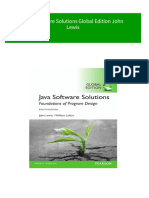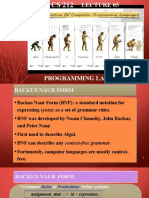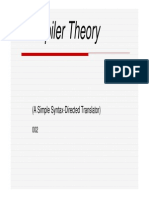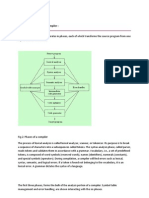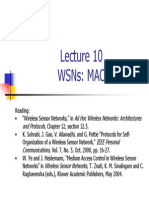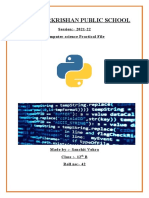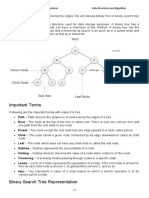Recursive Descent Parsing
Uploaded by
Manoj Kumar GRecursive Descent Parsing
Uploaded by
Manoj Kumar GRecursive descent parsing with BNF grammars - TechHui
http://www.techhui.com/profiles/blogs/1702911:BlogPost:1683
Search Sign Up Sign In
Hawaii's Technology and New Media Community Main My Page Members Events Forum Groups Photos Videos Blogs Listings Directory FAQ Coders More All Blog Posts My Blog Add
Recursive descent parsing with BNF grammars
Posted by Clifton Royston on December 20, 2007 at 9:38am View Blog (This is a modified repost of a post I recently put up on our company's wiki, explaining a very old CS concept/approach which seems to be rather neglected lately in production use.)
Introduction
If you're implementing any sort of miniature language as part of some software (query language, scripting capability) or even just attempting to parse structured input of some kind, using the full-boogie compilerbuilder tools like YACC, bison, and friends can seem like overkill. If you just try to write a completely ad-hoc parser off-the-cuff, however, you'll find it laborious, painful, and likely find the result to be full of bugs and nasty corner cases. However, there's a happy medium, which is recursive descent parsing. I'm going to give you a quick hand-wavy explanation of how to use it.
Overview of Recursive Descent Parsing
Recursive Descent Parsing (RDP) is a powerful technique for implementing languages or parsing inputs conforming to some syntax, as long as the syntax can be expressed in BNF (Backus-Naur form) or EBNF (Extended Backus-Naur Form). Recursive descent parsers are sometimes described as LL(k) grammars, where k defines the number of tokens of look-ahead needed, usually 1. Until the advent of "compiler-compiler" tools like YACC, essentially all compilers were written by hand using recursive descent parsers, and it's still not a terribly onerous task because the translation from the grammar to a recursive parser is extremely straightforward, almost mechanical. Given a grammar in BNF or EBNF, you can translate it to a slightly simpler BNF form which obeys certain constraints. Once you have the BNF there will be a single routine corresponding to each left-hand-side (LHS) item or "production" in the grammar, which will end up calling the routines corresponding to each entry on its right-hand-side (RHS).
Example of BNF conversion to RDP
Let's assume we're trying to parse a simple "calculator" input, with integer expressions combined with +,-,*,/ and possibly grouped with parentheses. This is simple enough to explain in a brief example. EBNF grammar for simple integer expressions:
Expr := Term | Term '+' Term | Term '-' Term Term := Factor | Factor '*' Factor | Factor '/' Factor Factor := RealNum | '-' RealNum | '(' Expr ')' RealNum := Digit +
Note: In reality, for practicality's sake we'd probably match RealNum as a token with a pattern-matching rule rather than in EBNF.
BNF left-factorized simplification of EBNF grammar: To convert the grammar to a parser, begin by converting it to the simpler BNF form, which eliminates any use of optional elements ([ ] or ?), any use of repetition operators (*) and any use of parenthesis operators for grouping. This can always be done at the expense of a slightly longer simple BNF form. We also must transform the grammar (which again may introduce some new non-terminal symbols) so that there is never a self-recursive or recursive derivation of a given symbol on the left side of a rule, and left-factor it, i.e. modify it so that whenever a given symbol appears as the first element in two or more possible derivations of a given symbol, it gets "factored out" for common processing, by splitting it into two sub-rules. This gives us:
Expr := Term ExprTail ExprTail := nil | '+' Term | '-' Term Term := Factor TermTail TermTail := nil | '*' Factor | '/' Factor Factor := RealNum | '-' RealNum | '(' Expr ')' RealNum := Digit RestOfNum RestOfNum := nil | Digit RestOfNum
Simplified parser code corresponding to BNF grammar: Translating this quite mechanically into very simplified code, assuming we have a TokenSource type with "peekToken" and "nextToken" methods, gives us code something like the following:
void ParseExpr( TokenSource t ) { ParseTerm( t ); ParseExprTail( t );
1 of 3
1/12/2013 12:06 PM
Recursive descent parsing with BNF grammars - TechHui
http://www.techhui.com/profiles/blogs/1702911:BlogPost:1683
} void ParseExprTail( TokenSource t ) { string s = t.peekToken(); if ( s == '+' ) { s = t.nextToken(); ParseTerm( t ); } else if ( s == '-' ) { s = t.nextToken(); ParseTerm( t ); } else { // nil } } void ParseTerm( TokenSource t ) { ParseFactor( t ); ParseTermTail( t ); } void ParseTermTail( TokenSource t ) { string s = t.peekToken(); if ( s == '*' ) { s = t.nextToken(); ParseFactor( t ); } else if ( s == '/' ) { s = t.nextToken(); ParseFactor( t ); } else { // nil }
etc. As you can see, it's a very mechanical process. It almost takes less time to write the code than it does to format this blog post. I've slightly glossed over the need for the parser to do something and return its results; in a real parser, the routines would be returning a pointer to the expression tree it had built thus far, or perhaps evaluating it on the fly and returning a real.
Web links:
General information on BNF and EBNF
BNF and EBNF: What are they and how do they work? Wikipedia on Backus-Naur form
Recursive Descent Parsers for .Net programmers
I found an interesting blog entry from a teacher at the IT University of Copenhagen, Denmark with a note about how to write scanners and parsers in C#. If you're interested in learning more, it has a good introductory explanation of the relationship between grammars (productions) and parsing, as well as more detailed examples of parsing code in C#. You should find it easy to apply this approach in any language. Views: 2639 Share Twitter Facebook
Like 0
Comment
You need to be a member of TechHui to add comments!
Join TechHui
Comment by Cameron Souza on December 27, 2008 at 6:37pm Nice post! I hope to see more posts on this subject. Are you doing this at work or just for fun? Have you used JavaCC?
Comment by Ken Berkun on January 2, 2008 at 8:49am Hey, nice to see a good technical article. Thanks for posting. Ken
Comment by Garth Henderson on December 30, 2007 at 5:42pm The ParserNotes.pdf with C# is of great interest to me. The best business application development system that I've worked with (Unix/C++) used YACC to create P-Code from visual painters. I'm currently trying to recreate an environment within VS (w/C#) that is as good as this system was. Your post has got me thinking. Thanks.
Comment by Daniel Leuck on December 20, 2007 at 2:12pm Thank you for the great post! I've used Javacc and its tree generating preprocessor JJTree for a number of projects over the past few years. I really love these tools. Its easy to get started by downloading one of the grammars. I got started by adding some Java 5 language constructs to the BeanShell grammar.
2 of 3
1/12/2013 12:06 PM
Recursive descent parsing with BNF grammars - TechHui
http://www.techhui.com/profiles/blogs/1702911:BlogPost:1683
Sergey Dmitriev from JetBrains has done a lot of interesting work on tools for generating DSLs. He is currently working on a language workbench for IntelliJ IDEA. With all the buzz around LOP (language oriented programming) and DSLs (Domain Specific Languages), we are sure to see a lot of interesting tools coming out to assist in the creation of new languages and dialects. RSS Welcome to TechHui
Sign Up
or Sign In Or sign in with:
Sponsors
2013 Created by Daniel Leuck. Badges | Report an Issue | Terms of Service
3 of 3
1/12/2013 12:06 PM
You might also like
- Java Software Solutions Global Edition John Lewis All Chapter Instant Download100% (2)Java Software Solutions Global Edition John Lewis All Chapter Instant Download84 pages
- Compiler Construction (CS4623) : Course Instructor: Ms. Tayyaba ZaheerNo ratings yetCompiler Construction (CS4623) : Course Instructor: Ms. Tayyaba Zaheer35 pages
- Parsing, Lexical Analysis, and Tools: William CookNo ratings yetParsing, Lexical Analysis, and Tools: William Cook16 pages
- What Is Parsing: Parsing Is The Process of Analyzing An Input Sequence in OrderNo ratings yetWhat Is Parsing: Parsing Is The Process of Analyzing An Input Sequence in Order9 pages
- CS 3723 - Programming Language: 1. Introductory StuffNo ratings yetCS 3723 - Programming Language: 1. Introductory Stuff11 pages
- Lec02 Programming Language SpecificationNo ratings yetLec02 Programming Language Specification36 pages
- What Characterizes A Language: A: BC Foo) A, B (No ratings yetWhat Characterizes A Language: A: BC Foo) A, B (10 pages
- Compiler Theory: (A Simple Syntax-Directed Translator)No ratings yetCompiler Theory: (A Simple Syntax-Directed Translator)50 pages
- Second Phase of The Compiler. Main Task:: Lexical Analyzer Rest of Front End Parser Source Tree Parse Req Token IRNo ratings yetSecond Phase of The Compiler. Main Task:: Lexical Analyzer Rest of Front End Parser Source Tree Parse Req Token IR13 pages
- Lecture 7-8 - Context-Free Grammars and Bottom-Up ParsingNo ratings yetLecture 7-8 - Context-Free Grammars and Bottom-Up Parsing39 pages
- In Other Words: How Does The Computer Evaluate The Following Expression? 5 2+3 2+50/10No ratings yetIn Other Words: How Does The Computer Evaluate The Following Expression? 5 2+3 2+50/1017 pages
- Lecture04 Week06 TopDownParsing 1 - CompilersNo ratings yetLecture04 Week06 TopDownParsing 1 - Compilers48 pages
- Comp Review: Compilers: Fall 1996 Textbook: "Compilers" by Aho, Sethi & UllmanNo ratings yetComp Review: Compilers: Fall 1996 Textbook: "Compilers" by Aho, Sethi & Ullman10 pages
- Practice Questions For Chapter 3 With AnswersNo ratings yetPractice Questions For Chapter 3 With Answers9 pages
- (ACM SIGFORTH Newsletter 1990-Dec 01 Vol. 2 Iss. 2) Rodriguez, Brad - A BNF Parser in FORTH (1990) (10.1145 - 122094.122095) - Libgen - Li-1No ratings yet(ACM SIGFORTH Newsletter 1990-Dec 01 Vol. 2 Iss. 2) Rodriguez, Brad - A BNF Parser in FORTH (1990) (10.1145 - 122094.122095) - Libgen - Li-16 pages
- Ch3 SyntaxAnalysispdf 2024 01 01 08 48 28No ratings yetCh3 SyntaxAnalysispdf 2024 01 01 08 48 28134 pages
- BNF and EBNF - What Are They and How Do They WorkNo ratings yetBNF and EBNF - What Are They and How Do They Work4 pages
- Grammars: Definitions Grammars Backus-Naur Form DerivationNo ratings yetGrammars: Definitions Grammars Backus-Naur Form Derivation19 pages
- Describing Syntax and Semantics: CSE 325/CSE 425: Concepts of Programming LanguageNo ratings yetDescribing Syntax and Semantics: CSE 325/CSE 425: Concepts of Programming Language46 pages
- WSNS: Localization: Ad Hoc Wireless Networks: Architectures and ProtocolsNo ratings yetWSNS: Localization: Ad Hoc Wireless Networks: Architectures and Protocols8 pages
- WSNS: Sensor Management: Ad Hoc Wireless Networks: Architectures and Protocols Wireless Sensor NetworksNo ratings yetWSNS: Sensor Management: Ad Hoc Wireless Networks: Architectures and Protocols Wireless Sensor Networks32 pages
- Network Simulator 2 - To Implement A New ProtocolNo ratings yetNetwork Simulator 2 - To Implement A New Protocol14 pages
- WSNS: Mac: Ad Hoc Wireless Networks: Architectures and Protocols IEEE Personal Communications Wireless Sensor NetworksNo ratings yetWSNS: Mac: Ad Hoc Wireless Networks: Architectures and Protocols IEEE Personal Communications Wireless Sensor Networks12 pages
- Reading: - "Wireless Lans and Pans," in Ad Hoc Wireless NetworksNo ratings yetReading: - "Wireless Lans and Pans," in Ad Hoc Wireless Networks49 pages
- Name Contactperson Mobile Address Phone Fax E-MailNo ratings yetName Contactperson Mobile Address Phone Fax E-Mail1 page
- B.tech in Computer Science and Engineering CSE Second Year 2024 25No ratings yetB.tech in Computer Science and Engineering CSE Second Year 2024 25106 pages
- 2nd Puc Computer Science Question Papers-2006 To 2011No ratings yet2nd Puc Computer Science Question Papers-2006 To 201132 pages
- 104 - PROGRAMMING AND PROBLEM SOLVING THROUGH 'C Language PDFNo ratings yet104 - PROGRAMMING AND PROBLEM SOLVING THROUGH 'C Language PDF3 pages
- Important Terms: Chapter 5 - Graph and Tree Data Structures Data Structures and AlgorithmNo ratings yetImportant Terms: Chapter 5 - Graph and Tree Data Structures Data Structures and Algorithm20 pages
- Recursion: by Yogita Deshmukh Department of Training and Placement VNIT NagpurNo ratings yetRecursion: by Yogita Deshmukh Department of Training and Placement VNIT Nagpur48 pages
- A Journey From Amateur To Skilled ProfessionalNo ratings yetA Journey From Amateur To Skilled Professional11 pages
- What Is C++? What Are The Advantages of C++?No ratings yetWhat Is C++? What Are The Advantages of C++?22 pages
